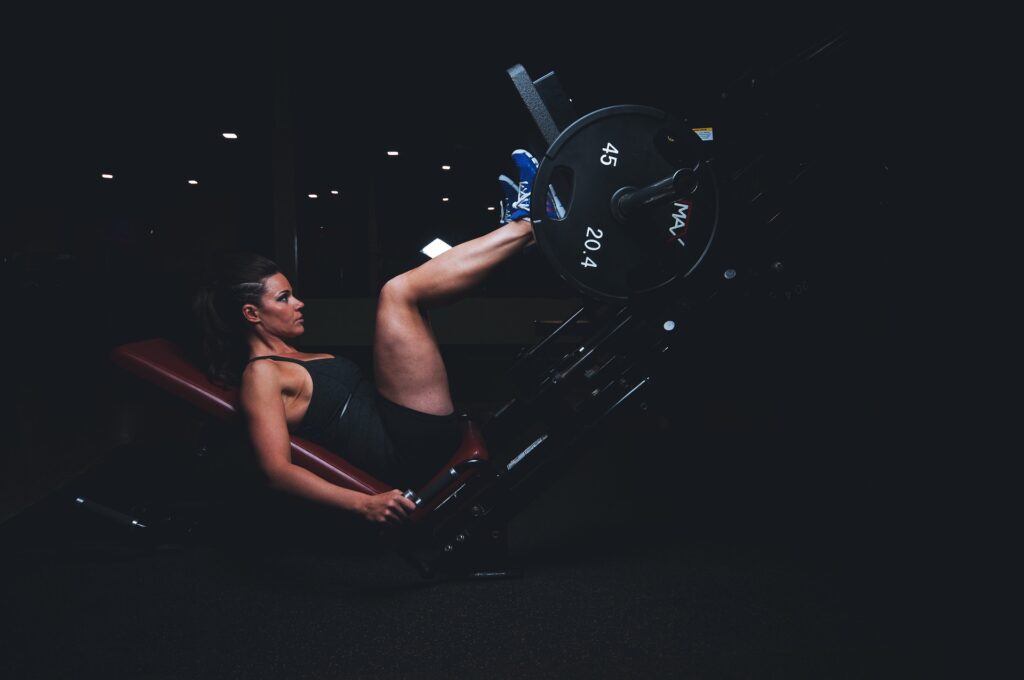Most women believe that old saying which goes “No pain, no gain.” That old adage isn’t really true and tends to cause a lot of women’s injuries because they overdo it.
You don’t have to kill yourself at the gym, run a marathon, or spend most of your time exercising to get firm muscles or burn off mega calories.
Simply by following a few rules, women can improve the results from exercise, without losing their time or hurting themself.
8 Simple Rules for Women
We publish 8 simple rules for women to get maximum results from their exercise routine without wasting a fortune on fitness equipment and accessories.
Rule #1 – Prepare to Exercise
This means keeping a gym bag in your car with running shoes and a sports bra, perhaps an extra stick of deodorant, minimum. This eliminates any excuses such as “I only have on high heels”, “I can’t go jogging in this bra”, or “I will stink when I get back to the office”. You could also keep some workout clothes as well, but having shoes and a sports bra with you at all times means never having to say “I can’t.”
Rule #2 – Be the Early Bird
We realize that for some women, this isn’t possible, but for most women, getting up early and getting your exercise out of the way clears up the entire day for all the unexpected things that will give you excuses not to exercise later on.
Rule #3 – Be like Gumby
In other words, be flexible! Be flexible in both mind and body. For example, if the gym was closed because of a leaking roof, don’t use that as an excuse to not go walking on your lunch break or find another location to go to after work.
Don’t forget to keep your body flexible as well. Those pre-workout warm-ups and post-workout cool downs and stretches are really, really important ladies! Don’t skip them!
Rule #4 – Hit the Dumbbells before the Treadmill
Studies have shown that women who do strength training before their cardio lose more fat than those who do the opposite.
Rule #5 – Don’t Sit to Improve the Bottom Line
Anytime you get the chance, do some squats or even just squeeze those cheeks together to get a beautiful booty. Are you talking on the phone or on a conference call? Walk back and forth and squeeze those cheeks before you turn around.
Rule #6 – Push Your Limits
High Intensity Interval Training, or HIIT, is used by athletes all over the world to encourage their bodies to drop excess fat and keep their metabolism revved up. Doing HIIT exercises once or twice a week can lead to major weight loss.
Rule #7- Take the Stairs and Do the Two Step
Every chance you get, take the stairs, rather than the elevator or the escalator. This will burn calories and tone your lower half. If you are wearing the proper shoes, consider taking those stairs two at a time to burn fat like crazy.
Rule #8 – Beat the Afternoon Slump with a Power Walk
Too many women turn to Starbucks or the vending machine to get an afternoon boost. Unfortunately, these also boost your waistline. Go for a short power walk instead. A quick 20-minute walk (10 minutes in one direction, then turn around) will burn as many as 75 calories and will bring fresh blood to your brain, causing you to wake up naturally.
Basic Guidelines for Exercise for Women
Exercise is a key component of any weight management plan for women. Here are some basic guidelines to help women get started and stay on track with their exercise routine:
- Choose Activities You Enjoy: Whether it’s dancing, hiking, swimming, or cycling, finding activities that you enjoy will make it easier to stick to your exercise routine. Experiment with different types of exercise until you find what works best for you.
- Start Slowly and Progress Gradually: If you’re new to exercise or getting back into it after a break, start slowly and gradually increase the intensity and duration of your workouts. This will help prevent injuries and make it easier to stick to your routine over the long term.
- Incorporate Cardiovascular Exercise: Cardiovascular exercise, such as brisk walking, jogging, or aerobics, helps burn calories and improve heart health. Aim for at least 150 minutes of moderate-intensity cardio each week, or 75 minutes of vigorous-intensity cardio.
- Add Strength Training: Strength training helps build lean muscle mass, which can increase metabolism and aid in weight loss. Include exercises that target all major muscle groups, such as squats, lunges, push-ups, and rows, at least two days a week.
- Include Flexibility and Balance Exercises: Flexibility and balance exercises, such as yoga or tai chi, can help improve range of motion, prevent injuries, and promote relaxation. Aim to incorporate flexibility and balance exercises into your routine at least two to three times a week.
- Listen to Your Body: Pay attention to how your body feels during and after exercise. If you experience pain or discomfort, stop and rest. It’s important to listen to your body’s signals and avoid overtraining.
- Stay Hydrated and Fuel Your Body: Drink plenty of water before, during, and after exercise to stay hydrated. Fuel your body with a balanced diet that includes plenty of fruits, vegetables, whole grains, and lean protein to support your workouts and promote overall health.
- Make It a Habit: Consistency is key when it comes to exercise. Schedule regular workouts into your weekly routine and treat them like any other appointment. By making exercise a habit, it will become easier to stick to over time.
By following these basic guidelines for exercise, women can improve their overall health, manage their weight, and feel great both physically and mentally. Remember to consult with a healthcare professional before starting any new exercise program, especially if you have any underlying health conditions.
What’s the Best Workout Schedule for Women?
When it comes to creating a workout schedule for women, it’s essential to find a balance between consistency, variety, and rest. Here’s a sample workout schedule that can be tailored to individual preferences and fitness levels:
- Monday: Strength Training
- Focus on strength training exercises targeting major muscle groups, such as squats, lunges, push-ups, and rows.
- Perform 3 sets of 8-12 repetitions for each exercise, with a one-minute rest between sets.
- Include both compound exercises (working multiple muscle groups) and isolation exercises (targeting specific muscles).
- Tuesday: Cardiovascular Exercise
- Engage in 30-45 minutes of moderate to vigorous-intensity cardiovascular exercise, such as brisk walking, jogging, cycling, or dancing.
- Choose activities that you enjoy to make the workout more enjoyable and sustainable.
- Alternatively, participate in a group fitness class or use cardio equipment at the gym.
- Wednesday: Active Rest or Flexibility
- Take a break from intense workouts and focus on active rest or flexibility exercises.
- Go for a leisurely walk, practice yoga, or engage in a stretching routine to improve flexibility and mobility.
- Active rest days help promote recovery while still keeping you active.
- Thursday: Interval Training
- Incorporate high-intensity interval training (HIIT) or circuit training into your workout.
- Alternate between periods of high-intensity exercise and rest or low-intensity recovery.
- HIIT workouts can be shorter in duration (20-30 minutes) but provide an effective calorie burn and cardiovascular challenge.
- Friday: Strength Training
- Repeat the strength training routine from Monday, focusing on different exercises or muscle groups.
- Adjust the intensity or resistance to continue challenging your muscles and promoting strength gains.
- Saturday: Cardiovascular Exercise or Outdoor Activity
- Engage in another session of cardiovascular exercise, similar to Tuesday’s workout.
- Alternatively, participate in outdoor activities such as hiking, swimming, or playing sports for a fun and refreshing workout.
- Sunday: Rest Day
- Allow your body to rest and recover from the week’s workouts.
- Use this day to relax, engage in low-impact activities, or enjoy leisure time with friends and family.
Remember to listen to your body and adjust the intensity and duration of your workouts as needed. It’s also essential to include rest days in your schedule to prevent burnout and reduce the risk of overtraining injuries. Experiment with different workout routines and schedules to find what works best for you and fits into your lifestyle.
How Long Should Women Workout for Maximum Results?
The duration of workouts for maximum results can vary depending on individual fitness goals, fitness level, and the type of exercise being performed. However, here are some general guidelines for the duration of workouts for women to achieve maximum results:
- Cardiovascular Exercise: For cardiovascular health and weight management, aim for at least 150 minutes of moderate-intensity aerobic exercise or 75 minutes of vigorous-intensity aerobic exercise per week, as recommended by the American Heart Association. This can be broken down into sessions of 30-60 minutes, five days a week.
- Strength Training: Strength training sessions can range from 30 to 60 minutes, depending on the intensity and number of exercises performed. Aim to work all major muscle groups at least two days a week, with a day of rest in between to allow for muscle recovery and growth.
- High-Intensity Interval Training (HIIT): HIIT workouts typically range from 20 to 30 minutes in duration, including alternating periods of high-intensity exercise and rest or low-intensity recovery. HIIT can be an effective way to maximize calorie burn and improve cardiovascular fitness in a shorter amount of time.
- Flexibility and Mobility: Incorporating flexibility and mobility exercises into your routine can help improve range of motion, prevent injuries, and promote recovery. Aim for at least 10-15 minutes of stretching and mobility work after each workout or on rest days.
- Consistency is Key: Regardless of the duration of your workouts, consistency is key to achieving maximum results. Aim to exercise regularly, sticking to a schedule that works for your lifestyle and allows for adequate rest and recovery between sessions.
- Listen to Your Body: Pay attention to how your body responds to exercise and adjust the duration and intensity of your workouts accordingly. It’s important to challenge yourself, but also to avoid overtraining and burnout.
Ultimately, the most important factor in achieving maximum results from your workouts is finding a balance between intensity, duration, and frequency that works for you and supports your overall health and fitness goals. Experiment with different types of exercise and workout durations to find what feels most effective and sustainable for you in the long term.
Exercise Safety Tips for Women
Exercise safety is crucial for women to prevent injuries and ensure a positive and effective workout experience. Here are some important exercise safety tips specifically tailored for women:
- Consult with a Healthcare Professional: Before starting any new exercise program, especially if you have any pre-existing health conditions or concerns, consult with your healthcare provider. They can provide personalized advice and guidance based on your medical history and fitness level.
- Start Slowly and Progress Gradually: If you’re new to exercise or returning after a hiatus, start with low-intensity workouts and gradually increase the intensity, duration, and frequency over time. This approach helps prevent injuries and allows your body to adapt to the demands of exercise.
- Warm-Up Properly: Always begin your workout with a proper warm-up to prepare your body for exercise. Include dynamic movements such as arm circles, leg swings, and light cardio to increase blood flow to your muscles and joints.
- Use Proper Form: Focus on maintaining proper form and technique during exercises to minimize the risk of injury and maximize results. If you’re unsure about how to perform an exercise correctly, seek guidance from a qualified fitness instructor or personal trainer.
- Listen to Your Body: Pay attention to how your body feels during exercise. If you experience pain, discomfort, dizziness, or shortness of breath, stop immediately and rest. Pushing through pain can lead to injury and setbacks.
- Stay Hydrated: Drink plenty of water before, during, and after exercise to stay hydrated and maintain optimal performance. Dehydration can impair physical and cognitive function and increase the risk of heat-related illnesses.
- Wear Appropriate Clothing and Footwear: Choose workout clothing that is comfortable, breathable, and allows for freedom of movement. Invest in supportive athletic shoes that provide adequate cushioning and stability for your chosen activities.
- Incorporate Strength Training: Including strength training in your exercise routine can help improve muscle strength, bone density, and overall functional fitness. Start with light weights and gradually increase resistance as you get stronger.
- Cool Down and Stretch: After completing your workout, take time to cool down and stretch your muscles. This helps reduce muscle soreness, improve flexibility, and promote relaxation. Focus on stretching all major muscle groups, holding each stretch for 15-30 seconds without bouncing.
- Listen to Your Body for Recovery: Allow your body time to recover between workouts. Incorporate rest days into your routine to prevent overtraining and promote muscle repair and growth. Get adequate sleep and practice stress-reduction techniques to support overall recovery and well-being.
By following these exercise safety tips, women can enjoy the benefits of regular physical activity while minimizing the risk of injury and promoting long-term health and fitness.



0 Comment